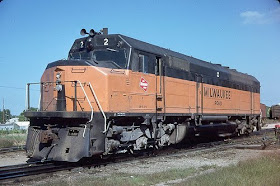
Southern Pacific Railroad's AC-12 class of cab forward steam locomotives was the last class of steam locomotives ordered by Southern Pacific. They were built by Baldwin Locomotive Works during World War II, with the first, number 4275, entering service on October 27, 1943, and the last, 4294, on March 19, 1944.
SP used the AC-12s for a little over a decade with the first retirements occurring on April 5, 1955, and the last on September 24, 1958. All but one of this class, number 4294, was scrapped.
The cab forward design was widely used by the Southern Pacific Railroad, which developed it to deal with the peculiar problems of its routes. The 39 long tunnels and nearly 40 miles (64 km) of snow sheds of the Sierra Nevada Mountains could funnel dangerous exhaust fumes back into the crew compartment of a conventional locomotive. After a number of crews nearly asphyxiated, someone had the idea of running his locomotive in reverse. This meant that the tender was leading the train, which introduced new problems. The tender blocked the view ahead and put crewmen on the wrong sides of the cab for seeing signals. The tenders were not designed to be pushed at the lead of the train, which limited speeds. Southern Pacific commissioned Baldwin Locomotive Works to build a prototype cab-forward locomotive, then ordered more before the prototype had even arrived.
All of the cab-forwards were oil-burning locomotives, which meant there was little trouble involved putting the tender at what would normally be the front of the locomotive. The oil and water tanks were pressurized so that both would flow normally even on uphill grades. Visibility from the cab was superb, such that one crewman could easily survey both sides of the track. There were concerns about what would happen to the crew in the event of a collision, and at least one fatal accident occurred on the Modoc Line when a moving locomotive struck a flat car. Turning the normal locomotive arrangement around also placed the crew well ahead of the exhaust fumes, insulating them from that hazard. One problematic aspect of the design, however, was the routing of the oil lines; because the firebox was located ahead of the driving wheels (instead of behind them, the usual practice), oil leaks could cause the wheels to slip. A nuisance under most conditions, it resulted in at least one fatal accident. This occurred in 1941 when a cab-forward with leaking steam and oil lines entered the tunnel at Santa Susana Pass near Los Angeles. The tunnel was on a grade, and as the slow-moving train ascended the tunnel, oil on the rails caused the wheels to slip and spin. The train slipped backwards and a coupler knuckle broke, separating the air line, causing an emergency brake application and stalling the train in a tunnel that was rapidly filling with exhaust fumes and steam. The oil dripping on the rails and ties then ignited beneath the engine cab, killing the crew.
No other North American railroad ordered cab-forward locomotives, although some, like the Western Pacific, did consider the type. Built to deal with difficult terrain, these remarkable locomotives became an easily recognizable symbol of the Southern Pacific. One example of the type, Southern Pacific 4294, is kept at the California State Railroad Museum in Sacramento, California. It is a 4-8-8-2 locomotive and is the only one to escape being scrapped.
See Other Railroad T-Shirts: Railroad T-Shirt - AT&SF (Santa Fe) Alco PA-1 - Sizes Kids Small To Adult XXXL / Railroad T-Shirt - AT&SF (Santa Fe) SD70Ms at San Francisco Peaks - Sizes Kids Small To Adult XXXL
See Also: Intermountain Railway Company HO Scale AC-12 4-8-8-2 Locomotive - Southern Pacific / Railroading On DVD! - Southern Pacific Cab Forward Collection
Other Southern Pacific Items: Athearn HO Scale SD40T-2 Locomotive - Southern Pacific/ Intermountain Railway Company HO Scale AC-12 4-8-8-2 Locomotive - Southern Pacific / Athearn HO Scale SD70M Locomotive - Southern Pacific / Athearn HO Scale AC4400 Locomotive - Southern Pacific / MTH HO Scale GS-4 4-8-4 Locomotive - Southern Pacific/ Bachmann HO Scale 4-8-4 GS-4 Locomotive - American Freedom Train #4449 / Bachmann HO Scale 4-8-4 GS-4 Locomotive - Southern Pacific (War Baby) / Athearn HO Scale C44-9W Locomotive - Southern Pacific / Athearn HO Scale GP40-2 Locomotive - Southern Pacific / Athearn HO Scale Bay Window Caboose - Southern Pacific




































